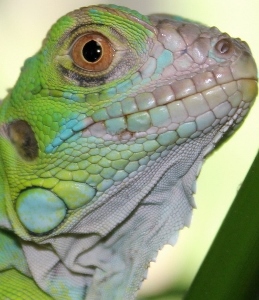
We’re sure they enjoyed their time basking in the spotlight over the past month, but now it’s time to bid the green iguana a fond farewell as our August edition of Animal of the Month comes to a close. We hope you enjoyed our tweets about these social and popular reptiles while you followed us on Twitter @ExoticPetVets. Here is a summary of our tweets in case you missed any. Did you know?:
- The green iguana (Iguana iguana) is also known as the common iguana.
- Green iguanas are popular pets, but they can be aggressive if they’re not handled or properly socialized.
- Adult green iguanas in captivity need an enormous amount of space.
- A full-grown adult male iguana can reach up to 2 metres (6.5 feet) long, while females are around 1.5 metres (5 feet).
- An enclosure for a captive green iguana should be a minimum of 12’ long x 6’ wide x 6’ high.
- Green iguanas are naturally found in Central and South America and parts of Mexico.
- Feral green iguana populations in Hawaii, California, Florida and Puerto Rico originate from escaped or released pets.
- In 2012, the green iguana population in Puerto Rico got so big, the government ordered them killed.
- Green iguanas are arboreal, meaning they live in trees and bushes.
- Green iguanas are sometimes called “chicken of the trees” in parts of Central America where iguana meat is eaten.
- In 1995, uprooted trees from two hurricanes carried some green iguanas to Anguilla where they’re not naturally found.
- Green iguanas have very long tails which they can use as a whip for defense.
- Green iguanas can lose their tails if they’re handled roughly. Their tails can grow back slowly and are duller in colour.
- Green iguanas have a distinctive row of spines, or a crest, running down their backs.
- Green iguanas have a parietal eye, which is also known as a “third eye” or pineal eye.
- This parietal eye is a photosensory gland that is a white spot on the top of the green iguana’s head.
- Despite it’s name, green iguanas can’t see out of the parietal eye but they can tell light from dark.
- The parietal eye helps green iguanas detect avian predators overhead. It also helps control body temperature & hormone production.
- Female green iguanas are bright green while males are duller and have orange on the crests and other parts of their body.
- In addition to being larger, male green iguanas have larger heads, jowls and dorsal crests than females.
- Male green iguanas also have larger femoral pores on their inner thighs than their female counterparts.
- Green iguanas are generally very social and in the wild can be seen foraging for food and basking in the sun together.
- Despite their good temperament, green iguanas are terrible pets for kids and are best left to serious reptile enthusiasts.

